|
|
|
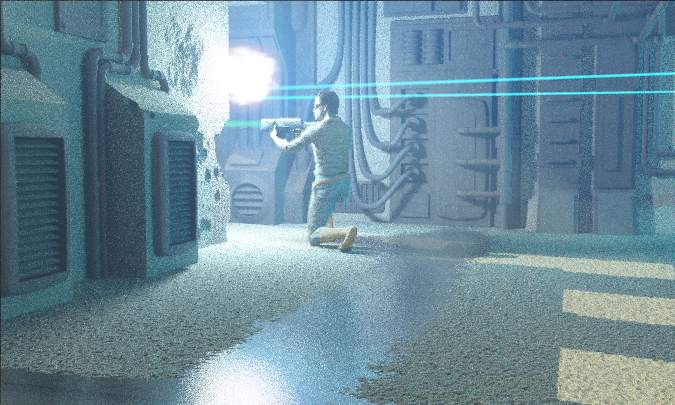
Pulse Lasers
Pulse lasers emit millisecond pulses of light that blast their way through their target. The vapor explosion from soft material is enough to blow it apart and blast out a wide hole. Hard material is melted and partially vaporized, and the melt is ejected from the hole by the high speed vapor jet. They do Beam damage, which goes against the lower of Mech Armor Score and Burn Armor score. With a temperature score of +14, there are no materials that can directly resist the beam at tight focus.
Pulse lasers use focused beams that start out wide at the gun and are focused to a small point at the target using optics.
Focused beams have a Focus score instead of a Spread score, representing how tightly the beam can be focused at distance.
The farther away the target is, the larger the spot and the less penetrating the beam will be - for every range band beyond the range score listed under Focus, AP gets +1 until it is zero. After that, Pen gets -2 RS and Wound gets +1 per range band.
Pulse lasers emit near-visible light - light in the short-wave and near infrared (IR), near ultraviolet (UV), and visible part of the spectrum.
Consequently, their beams will be attenuated by poor visibility due to particulates in the air such as smoke, dust, fog, mist, or smog.
| 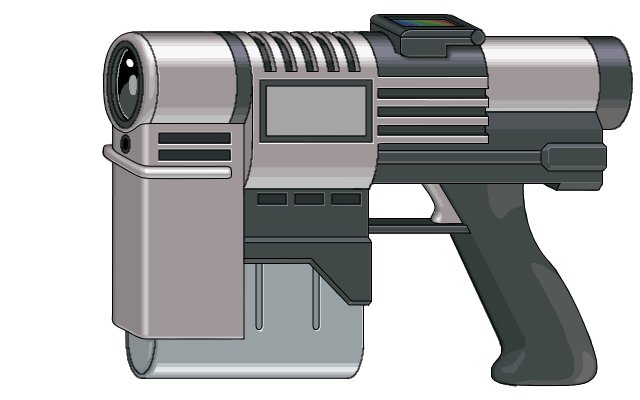
Since light from the target to the laser follows exactly the same path as the light in the beam from the laser to the target, lasers automatically hit where it looks like they are aimed, regardless of any bending or distortion of the beam. The typical aiming aid is a single lens reflex (SLR) scope, which uses the laser's own focusing optics as the scope to show where the beam will land, eliminating any parallax due to offset sights.
The optics needed to focus a laser and counteract atmospheric turbulence also automatically stabilize the beam. This is included in the listed stats, lasers cannot get any additional benefit from stabilization.
The built-in SLR laser scope has an adjustable magnification, providing up to an additional +2 to Aim. This comes with all of the limitations normally inherent with stabilized scopes.
All lasers can act as a laser sight, giving an additional +1 to Shoot skill checks when the sight is used (not cumulative with a smartlink to a HUD).
Laser light acts like any other light - it will pass through transparent materials like windows and air, and reflect off of mirrors. This allows a gunner to aim at the image of his target in the mirror, and the beam will reflect off the mirror in such a way as to hit the target. Typically, the high intensity of a focused beam is enough to degrade mirrored surfaces so that the reflectivity of the target does not matter, but surfaces encountered before the beam reaches its tight focus at the target can reflect the beam. Normal glass is opaque to much of the ultraviolet, although UV beams can burn or blast the glass out of the way like any other barrier.
Deflector screens are entirely transparent, and lasers can go right through them.
Adjusting Beams
Pulse lasers have very versatile beams, that can be tuned for many different effects.
It takes one action to adjust any one property of the beam.
-
Focused beams are assumed to focus automatically, in the same way a point-and-shoot camera autofocuses on its subject. Making sure the weapon focuses on the right thing is part of the Shoot skill for beam weapons.
However, a gunner can choose to intentionally defocus the beam at the target, so that it causes the effects of any chosen range that is greater than or equal to the target's range. This can be useful against lightly armored or unarmored targets to cause a more severe injury when the beam would normally over-penetrate.
-
Pulse lasers have adjustable energy. The energy per pulse can be decreased from the maximum. This will increase the SMES lifetime before the power is exhausted, and will increase the ROF by 1 RS for every RS decrease in the beam energy (semiautomatic designs are still semiautomatic, but the maximum number of shots they can fire in one action increases).
Use the damage from the table below, and decrease Focus by the change of the Wound score.
Pulse energy cannot be increased above the amount listed for the weapon.
| Energy | Pen | Wound | | 0.1 | 7 | -3¾ | | 0.15 | 8 | -3¼ | | 0.2 | 9 | -3 | | 0.3 | 10 | -2¼ | | 0.4 | 11 | -2 | | 0.5 | 12 | -1¾ | | 0.7 | 14 | -1½ |
| | Energy | Pen | Wound | | 1 | 16 | -1 | | 1.5 | 18 | -¾ | | 2 | 20 | -½ | | 3 | 22 | -¼ | | 4 | 25 | +0 | | 5 | 28 | +¼ | | 7 | 30 | +½ |
| | Energy | Pen | Wound | | 10 | 35 | +1 | | 15 | 38 | +1½ | | 20 | 42 | +1¾ | | 30 | 48 | +2 | | 40 | 55 | +2¼ | | 50 | 55 | +2½ | | 70 | 65 | +2¾ |
|

| | Battle Laser
|
This table can be extended ... ×1000 to Energy is ×10 to Pen and +7 to Wound score.
-
In addition to adjusting their energy, the pulse duration can also be compressed. This causes a wider wound channel, but less penetration. The user can choose up to +1 to Wound, but Pen will decrease by twice this number of RS.
-
Lasers can be adjusted to emit beams in multiple colors ranging from IR light through the entire Human-visible spectrum and into the UV. They can only emit light of a single color at once.
The listed default beam for lasers is in the short-wave IR, which is eye-safe and not prone to causing beam blindness to bystanders.
Lasers set to fire beams of another color add +1 to focus (near IR beams), +2 to Focus (red, orange, or yellow beams), +3 to focus (green, blue, or violet beams), or +4 to focus (UV-A and UV-B beams).
UV beams do not focus well in air, water, or other transparent media – for the small spot size needed to do damage, the light intensity is high enough that two photon absorption removes most of the energy from the beam. In air, water, or other transparent media UV beams that have a non-zero AP score are absorbed and do nothing – the beam must be defocused to the point where AP = 0. This is not a problem in vacuum, where UV beams keep their full AP score.
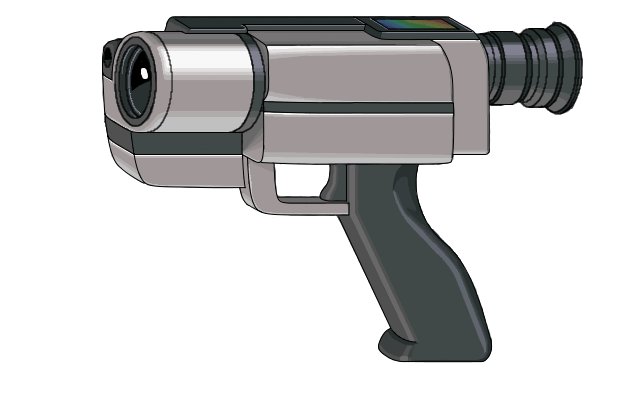
Most sapient species can see beams of any visible wavelength – red, orange, yellow, green, blue, and violet colors. Laer and Mants can also see UV-A and Gummis can also see near IR in addition to visible wavelengths. Tweechi and Pirang can see near IR, red, orange, and yellow light. Squirm can see short-wave IR, near IR, and all visible colors.
Those who cannot see the beam will not be able to easily tell where the laser is shooting from (although the plasma flash and sparks and blast from the laser incident on the target is obvious).
Those who can detect the beam's light will be able to see an obvious track along the beam path where the beam passes through air, water, or other transparent media (but not vacuum).
In addition, visible beams cause a brilliant flare at the target of the same color.
The listed Signature is the flash and audible signature from the blast at the point of incidence; if the laser is visible, it is also the visible signature of the beam trace and the visible signature of the incidence flash is increased by 7.
Detecting the beam trace allows you to pinpoint the location of the laser.
Green, blue, violet, and UV beams transmit well underwater, with a DA range of 25 meters. This decreases to 10 for yellow, 5 for orange, and 3 for red. IR light doesn't go through water, and the beam will lose 30 points of penetration per meter of water it goes through.
| Beam blindness: Any color of beam except for short-wave IR or UV-B beams can cause beam blindness.
Anyone capable of seeing short-wave IR or UV-B light can be affected by beam blindness from the beam colors they can see (if you cannot see short-wave IR or UV-B yourself but are using a sensor that can, the sensor can be blinded but you are safe).
Beam blindness occurs when the light scattered out of the beam where it is incident on the target gets focused by the eye's lens to a tiny spot on the retina, where it causes burns that can degrade vision.
This can happen whether or not you can see the beam – the parts of the eye that let through visible light also let through near IR and UV-A wavelengths that can be produced by lasers, even though these wavelengths might not be able to be detected by your photoreceptors they can still be focused to burning intensities.
Short-wave IR and UV-B are eye safe because the transparent parts of the eyes of most species are not transparent to these colors.
The place where a laser beam "hits" is called its point of incidence.
If you can see the point of incidence of a beam capable of causing beam blindness, find
2d6 - 2d6 + 2 × (beam Signature - range score to the point of incidence).
If 1 or higher, this is the vision penalty from the eye damage caused by the laser flash.
If the penalty is 7 or more, the victim is completely blind.
Gummis have lots of eyes all over their bodies, so about half of their eyes will be facing in another direction when the flash comes – cap the maximum vision penalty for Gummis at -1 per flash (multiple flashes can accumulate penalties to the point where all the Gummi's eyes are blind, but it will take several).
Flash protection eyewear will protect the wearer from beam blindness, eliminating any risk of vision damage from the beam.
Closing your eyes also provides full protection. If you close your eyes just before you pull the trigger of your own pulse laser, you don't risk eye injury but subtract 1 from your attack roll.
Humans, Pannovas, and enhanced animals who have their vision damaged can be healed in about a megasecond at a hospital.
Gummis can grow new eye zooids in about 2 megaseconds.
Regardless of the beam color, flash protection, or the beam blindness roll, any laser beam that directly strikes the eye will cause complete blindness to that eye (and very likely a lethal wound as well).
It is illegal for civilians to use non eye-safe beams in cities or where anyone else might be affected by beam blindness, even in cases where the shooting would otherwise be justified.
The penalties usually involve confiscation of the weapon and a hefty fine. A repeat offender is likely to lose their right to own or carry firearms.
In addition, a gunner that causes beam blindness in another will be liable for any harm caused (usually running about $10k for medical bills, penalties, and reparations per person injured).
| | Long range shooting: Short-wave IR is a good eye-safe wavelength to use when you need to penetrate armor, but it is short ranged. For shooting distant but lightly armored targets when eye safety is a concern switch to UV-B and defocus to AP 0. This causes full damage at 15 × the usual range, or +8 to the listed Focus score before damage starts decreasing.
|
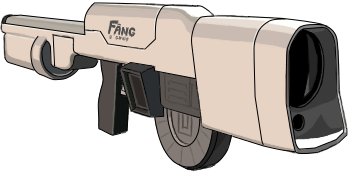 Power storage may be expensive, but energy is cheap. A full 1000 kJ of energy costs $0.001. The cost of recharging a pulse laser's SMES can usually be neglected. A laser's SMES energy store is usually so large that tracking ammunition can be neglected.
Power storage may be expensive, but energy is cheap. A full 1000 kJ of energy costs $0.001. The cost of recharging a pulse laser's SMES can usually be neglected. A laser's SMES energy store is usually so large that tracking ammunition can be neglected.
Many larger pulse laser weapons keep the beam generator (as associated pulse shaping electronics and power supplies) separate from the beam pointing telescope. The beam pointer acts like a robot turret (see Gear: Security), with the beam fed to the beam pointer using fiber optic cables. Just as with a robot turret, the beam pointer may be manually controlled with a joystick and display, or automatically controlled by a computer using targeting security software (see Gear: Security).
All lasers have RCL = -∞, Max = ∞, and Speed = 75000000 (effectively ∞ for most practical purposes). DA depends on local atmospheric conditions. In clear air DA can be neglected but mist, smoke, fog, dust, and other suspended particulates will give a -1 RS to Pen for every -1 penalty to vision-based Awareness rolls, and also give a +1 to the signature to spot the beam (but not the incidence flash or sound of the blast).
Against armor, they are considered to have a Sharp score of +2 for the purpose of determining blunt trauma.
| Description | Pen | Wound | AP | ROF | Ammo | Bulk | Aim | Str | Focus | Sig | Mass | Price | | Palm Laser | 10 | -2¼ | -4 | 3s | 1000 | -2 | +1 | -6 | +3 | +7 | 0.18|0.015 | 10|0.3 | | Pocket Laser Pistol | 14 | -1½ | -4 | 3s | 1000 | -1 | +2 | -4 | +6 | +9 | 0.45|0.035 | 25|0.7 | | Laser Pistol | 18 | -¾ | -4 | 3s | 1000 | +0 | +3 | -1 | +8 | +10 | 1|0.07 | 50|1.5 | | Heavy Laser Pistol | 22 | -¼ | -4 | 3s | 1000 | +½ | +3 | +1 | +9 | +11 | 1.8|0.15 | 100|3 | | Auto Laser | 20 | -½ | -4 | 10 | 5000 | +3½ | +7 | -2 | +10 | +10 | 3.5|0.5 | 180|10 | | Laser Carbine | 22 | -¼ | -4 | 3s,3 | 1000 | +3 | +7 | -3 | +11 | +11 | 2|0.15 | 120|3 | | Hunting Laser | 25 | +0 | -4 | 3s | 1000 | +3½ | +7 | -1 | +12 | +11 | 3.5|0.2 | 200|4 | | Battle Laser | 28 | +¼ | -4 | 3s,3 | 1000 | +3½ | +7 | -1 | +12 | +11 | 4.5|0.25 | 250|5 | | Big Game Laser | 35 | +1 | -4 | 1s | 400 | +3½ | +7 | +0 | +13 | +12 | 5|0.2 | 300|4 | | Sniper Laser | 35 | +1 | -4 | 1s,1 | 400 | +4 | +7 | +1 | +14 | +12 | 8|0.2 | 450|4 | | Elephant Laser | 38 | +1½ | -4 | 1s | 400 | +4 | +7 | +1 | +13 | +13 | 7|0.3 | 350|6 | | Assault Laser Pack | 35 | +1 | -4 | 3s,3 | 1000 | +3 | +7 | -1 | +14 | +12 | 4:6|0.5 | 600|10 | | Auto-Laser Pack | 28 | +¼ | -4 | 10 | 5000 | +3 | +7 | -1 | +13 | +11 | 4:7|1.2 | 600|25 | | Magnum Laser Pack | 38 | +1½ | -4 | 3s,3 | 1000 | +3 | +7 | -1 | +14 | +13 | 4:8|0.7 | 700|15 | | Heavy Laser Pack | 48 | +2 | -4 | 1s,1 | 400 | +3 | +7 | -1 | +15 | +14 | 4:10|0.6 | 800|12 | | Battlesuit Laser | 70 | +3¼ | -4 | 1s,1 | 400 | +5½ | +7 | +6 | +16 | +16 | 40|2 | 2k|40 | | Heavy Support Laser | 48 | +2 | -4 | 8 | 5000 | +6 | +7 | +6 | +15 | +14 | 35+7 | 2k|150 | | Strike Laser | 55 | +2½ | -4 | 10 | 5000 | +7 | +7 | +9 | +18 | +15 | 100+12 | 6k|250 | | Point Defense Laser | 55 | +2½ | -4 | 20 | 5000 | +8 | +7 | +12 | +19 | +15 | 250+12 | 15k|250 | | Sml. Laser Cannon | 100 | +4¾ | -4 | 1s,1 | 400 | +7½ | +7 | +9 | +19 | +18 | 120+6 | 7k|120 | | Lt. Laser Cannon | 160 | +6 | -4 | 1s,1 | 400 | +8½ | +7 | +13 | +21 | +19 | 350+20 | 20k|400 | | Blast | -2 RS | | (7) | | | | | | (-½) | | | | | Med. Laser Cannon | 200 | +6½ | -4 | 1s,1 | 400 | +9½ | +7 | +16 | +23 | +20 | 1k+40 | 60k|800 | | Blast | -2 RS | | (7) | | | | | | (+0) | | | | | Hvy. Laser Cannon | 300 | +7½ | -4 | 1s,1 | 400 | +10½ | +7 | +19 | +25 | +23 | 3k+150 | 180k|3k | | Blast | +0 RS | | (7) | | | | | | (+½) | | | | | X-Hvy. Laser Cannon | 380 | +8½ | -4 | 1s,1 | 400 | +11½ | +7 | +22 | +27 | +24 | 6k+300 | 400k|6k | | Blast | +½ RS | | (7) | | | | | | (+1) | | | | | Planetary Def. Laser | 2000 | +13½ | -4 | 10 | ∞ | +17½ | +7 | +39 | +54 | +31 | 2500k | 150M | | Blast | +6½ RS | | (7) | | | | | | (+4) | | | |
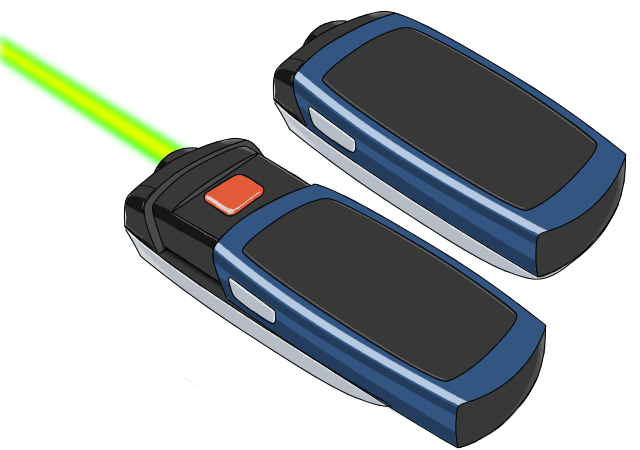 - Palm Laser: A palm laser is a small, easily concealable laser weapon, with an appearance similar to an early 21st century flip phone. To fire, the safety case slides back, revealing the trigger-button. It is not very ergonomic to actually fire and lacks external aiming aides - without its in-built laser sight or linked to an HUD via its smartlink, Aim becomes +0.
Energy per shot: 300 J
Aperture: 1 cm
- Pocket Laser Pistol: A slim laser pistol for concealed carry.
Energy per shot: 700 J
Aperture: 2 cm
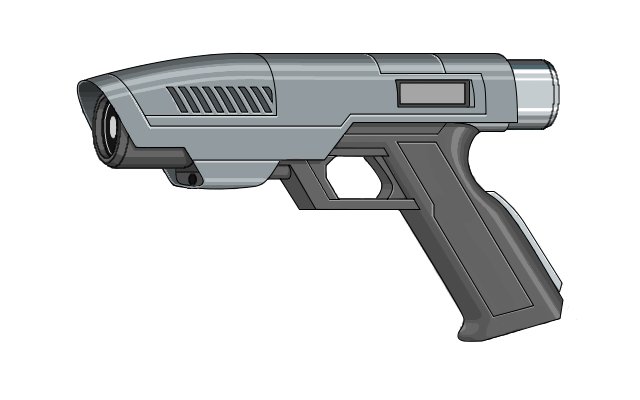 - Laser Pistol: The standard laser sidearm, common with police, civilians, and military officers.
Energy per shot: 1.5 kJ
Aperture: 3 cm
- Heavy Laser Pistol: A sidearm for those who feel a standard laser pistol doesn't offer enough oomph.
Energy per shot: 3 kJ
Aperture: 3 cm
- Auto Laser: This carbine-style longarm is designed to emit rapid-fire pulses, making it useful to special forces and SWAT teams.
Energy per shot: 2 kJ
Aperture: 5 cm
- Laser Carbine: A common laser weapon for hunting, self-defense, and military personnel not expected to encounter heavy armor.
Energy per shot: 3 kJ
Aperture: 5 cm
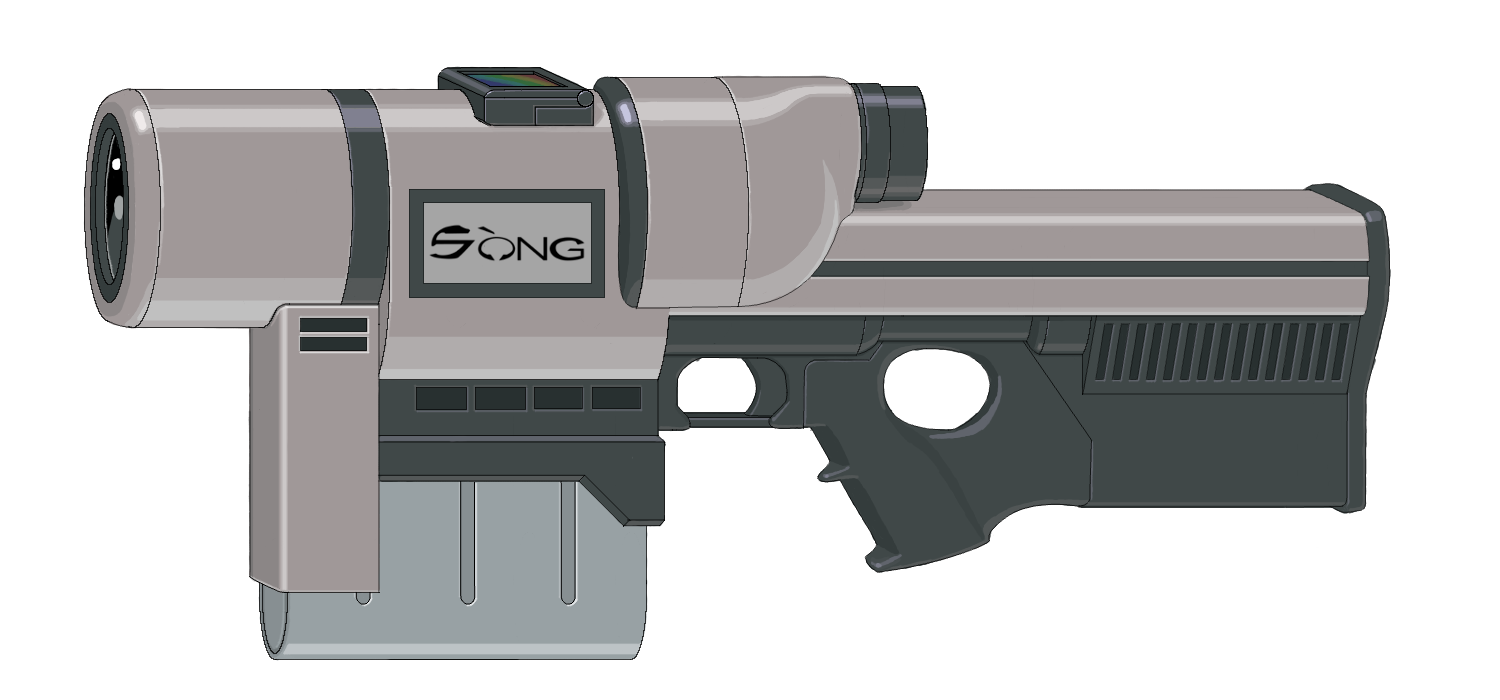 - Hunting Laser: A common hunting weapon, also used by some militaries as infantry weapons and police units to keep in the patrol vehicle.
Energy per shot: 4 kJ
Aperture: 7 cm
- Battle Laser: One of the most common infantry weapons. Battle lasers modified to not autofire are also favored by civilians as a hunting weapon.
Energy per shot: 5 kJ
Aperture: 7 cm
- Big Game Laser: This is a favored weapon for hunting large dangerous animals.
Energy per shot: 10 kJ
Aperture: 7 cm
 - Sniper Laser: A powerful laser longarm with a large focal array for long range shooting.
Energy per shot: 10 kJ
Aperture: 10 cm
- Elephant Laser: If you ever find yourself in need of dropping a charging bull elephant or a Tyrannosaurus rex, this is the gun for you.
Energy per shot: 15 kJ
Aperture: 7 cm
- Assault Laser Pack: This is a general purpose combat laser pack.
It allows more firepower than a single-piece laser longarm by putting the energy storage, power regulation, cooling, and beam generator into a backpack.
A a fiber optic cable directs the beam to a hand-held beam pointer with a rifle-like configuration.
The beam pointer can be stashed on the side of the pack when not being used, to reduce arm and shoulder fatigue when carrying the weapon for long periods of time.
Energy per shot: 10 kJ
Aperture: 10 cm
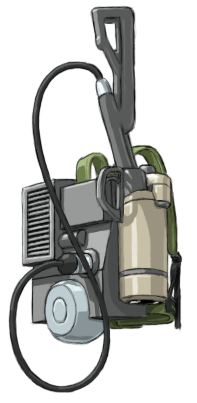 - Auto-Laser Pack: A laser for providing squad-level suppresive fire, filling a machine gun role. The energy storage and laser generator are carried in a backpack, with the laser beam fed into a rifle-configuration beam pointer via a fiber optic cable.
Energy per shot: 5 kJ
Aperture: 10 cm
- Magnum Laser Pack: This laser pack delivers more punch than lighter versions, for applications where extra damage is needed.
Energy per shot: 15 kJ
Aperture: 10 cm
- Heavy Laser Pack: A laser pack with a powerful beam for long range fire or taking out equipment, light armored vehicles, or heavily armored individuals. As with other laser packs, the beam generator and energy storage are worn in a back pack, and the beam routed to a hand-held beam pointer through a cable.
Energy per shot: 30 kJ
Aperture: 10 cm
- Battlesuit Laser: A laser designed for use by battlesuited troopers.
Energy per shot: 100 kJ
Aperture: 10 cm
- Heavy Support Laser: A rapid-fire laser designed to be used from a tripod or vehicle mount and capable of taking out battlesuited troops and light armor vehicles.
Energy per shot: 30 kJ
Aperture: 10 cm, Separatable beam pointer turret with mass 6 kg (included in the listed mass).
- Strike Laser: A stationary or vehicle-mounted light cannon.
Energy per shot: 50 kJ
Aperture: 20 cm, Separatable beam pointer turret with mass 45 kg (included in the listed mass).
- Point Defense Laser: A rapid-fire point-defense weapon.
Energy per shot: 50 kJ
Aperture: 30 cm, Separatable beam pointer turret with mass 150 kg (included in the listed mass).
- Laser Cannon: A stationary or vehicle-mounted large cannon.
- Small Laser Cannon:
Energy per shot: 300 kJ
Aperture: 15 cm, Separatable beam pointer turret with mass 18 kg (included in the listed mass).
- Light Laser Cannon:
Energy per shot: 1 MJ
Aperture: 20 cm, Separatable beam pointer turret with mass 45 kg (included in the listed mass).
- Medium Laser Cannon:
Energy per shot: 2 MJ
Aperture: 40 cm, Separatable beam pointer turret with mass 350 kg (included in the listed mass).
- Heavy Laser Cannon:
Energy per shot: 7 MJ
Aperture: 50 cm, Separatable beam pointer turret with mass 700 kg (included in the listed mass).
- Extra-Heavy Laser Cannon:
Energy per shot: 15 MJ
Aperture: 70 cm, Separatable beam pointer turret with mass 2 tons (included in the listed mass).
- Planetary Defense Laser: A gigantic laser, usually buried deep underground and firing through a wormhole to be focused by beam pointer satellites with 10 to 1000 meter diameter mirrors (not included in mass and cost).
The laser is powered by its own dedicated powerplant, typically a NOW generator (not included in mass and cost).
The listed Focus range score assumes a beam pointer satellite with a 1 km focal dish.
A constellation of these satellites orbiting at 5,000 km altitude giving full coverage to a world will be present on major worlds of the Verge Republic.
The laser will almost always use a blue, cyan, or green beam for an additional +3 to Focus score.
A common technique is to decrease the pulse energy and increase the rate of fire, and raster the beam across enemy formations from above.
Under standard operating conditions, this causes damage as a medium laser cannon, allows ROF 10,000, and decreases the Focus score by 7 (giving a range of maximum effect of 15,000 km using the 1 km focal dish assumed above and a blue or green beam).
Sweeping a 100 m wide swath advancing at 10 m/s (30 m per combat round) gives a Saturation score of +5 + 2× Size for every target in the swept area.
At this density of pulses, assess blast damage as a single blast using the base medium laser cannon blast Pen with +5 RS to the roll to anyone caught in the area.
Energy per shot: 2 GJ
Aperture: 1 km
When pulse lasers are installed on a vehicle, robot, or building, the laser itself is generally recessed into the structure for protection. The beam is collected by fiber optic cables and channeled into a focal array. The focal array is pointed using a robot turret or arm.
If the focal array's aperture is different from that of the pulse laser, increase the Focus score by the Score of (beam pointer aperture) - Score of (laser weapon's aperture).
Because the focal array already installed on the pulse laser is removed, reduce the weapon's mass by that of its focal array.
This can also be used to customize pulse laser weapons; by switching out focal arrays you can change the Focus score of the weapon.
|
| Aperture Size | Mass | Price
| | 2 cm | 35 g | $3 | | 3 cm | 0.12 kg | $10 | | 4 cm | 0.25 kg | $25 | | 5 cm | 0.5 kg | $45 | | 7 cm | 1.5 kg | $120 | | 10 cm | 4 kg | $400 | | 15 cm | 15 kg | $1.2 k | | 20 cm | 35 kg | $3 k | | 30 cm | 120 kg | $10 k | | 40 cm | 250 kg | $25 k | | 50 cm | 500 kg | $45 k | | 70 cm | 1.5 tons | $120 k | | 100 cm | 4 tons | $400 k |
|
Beam pointers are stabilized – they do not take penalties from the motion of what they are mounted on.
In addition, if operated with a targeting program (see InfoTech), their Aim score is equal to the Focus score of their laser plus the targeting program bonus.
Back to Vergeworlds Main Page
| |
|
|



 Power storage may be expensive, but energy is cheap. A full 1000 kJ of energy costs $0.001. The cost of recharging a pulse laser's SMES can usually be neglected. A laser's SMES energy store is usually so large that tracking ammunition can be neglected.
Power storage may be expensive, but energy is cheap. A full 1000 kJ of energy costs $0.001. The cost of recharging a pulse laser's SMES can usually be neglected. A laser's SMES energy store is usually so large that tracking ammunition can be neglected.




